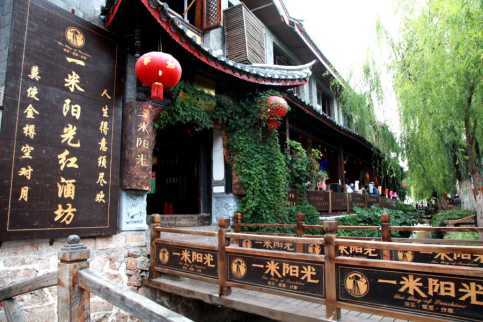
Although Yunnan Province is less developed economically, when compared with China’s eastern provinces, its tourism resources are so rich that one should not explore China without visiting Yunnan. From the world-famous Lijiang to lots of small ancient towns, from the amazing karst formations(喀斯特地貌) to the World Heritage Site Hani Terrace, Yunnan can be a complete eye-opener for even the most smart travelers. Here are three Yunnan destinations not to be missed, although we are sure that the place’s natural wonders and cultural landscapes are far beyond the sites listed here.
The Old Town of Lijiang
The Old Town of Lijiang, located in Southwest China’s Yunnan Province, is one of the last surviving ancient towns in China. The Old Town of Lijiang has been a commercial, political and cultural center of the Naxi people and other ethnic minorities for eight centuries.
Zhengying Ancient Village
Zhengying Village has a history of more than 600 years. In 1999, Zhengying Village was named as historical and cultural village of provincial level. After that it was given the name “No.1 Village in Yunnan”.
Naigu Stone Forest
A central part of Stone Forest Park that was listed as a UNESCO World Natural Heritage site in 2007, the 30-square-kilometer Naigu beautiful area is known as a natural museum of karst landforms. The word “naigu” means “ancient and black” in the language of the Yi ethnic minority group, a fitting description of the mass of blackish limestone(石灰岩) that formed about 270 million years ago. The Naigu attraction has much stone columns(柱) that appear as shapes ranging from animals and figures to towers and blockhouses. The highest is more than 40 meters tall.
1.Yunnan is rich in _________ resources.
A sightseeing
B economical
C cultural
D political
解析:选A。A 细节理解题。根据第一段第一句...its tourism resources are so rich that one should not explore China without visiting Yunnan.可知云南的旅游资源非常丰富,故选A。
2.How long has Lijiang been the commercial center of Naxi people?
A More than 600 years.
B For 800 years.
C Since 270 years ago.
D Since 2014.
解析:选B。B 细节理解题。根据第二段最后一句The Old Town of Lijiang has been a commercial, political and cultural center of the Naxi people and other ethnic minorities for eight centuries.可知丽江古城是作为纳西族和其他少数民族的政治、经济、文化中心达8个世纪之久,也就是800年,故选B。
3.Zhengying Village was named as “No. 1 Village in Yunnan” for its _________.
A beautiful scenery
B karst formations
C rich culture and long history
D developed economy
解析:选C。C 推理判断题。根据第三段可知郑营村在1999年被评为云南省级历史文化名村,赢得了“云南第一村”的称号,其获评的根本原因是historical和cultural,即悠久的历史和丰富的文化,故选C。
4.What is the color of the stones of Naigu Stone Forest?
A White.
B Yellow.
C Brown.
D Black.
解析:选D。D 细节理解题。根据最后一段第二句The word “naigu” means “ancient and black” in the language of the Yi ethnic minority group, a fitting description of the mass of blackish limestone that formed about 270 million years ago.可知“乃古”是彝语,意思是“古老的和黑色的”,正好描述了乃古石林的颜色,因此乃古石林的石头的颜色应该是黑色,故选D。
5.Where might you read this passage?
A In a news report.
B In a fashion magazine.
C In a travel book.
D In a geography book.
解析:选C。C 文章出处题。根据全文可知,文章介绍了云南的丽江古城、郑营古村和乃古石林,属于旅游版块,最有可能在有关旅游的书籍里面读到,故选C。